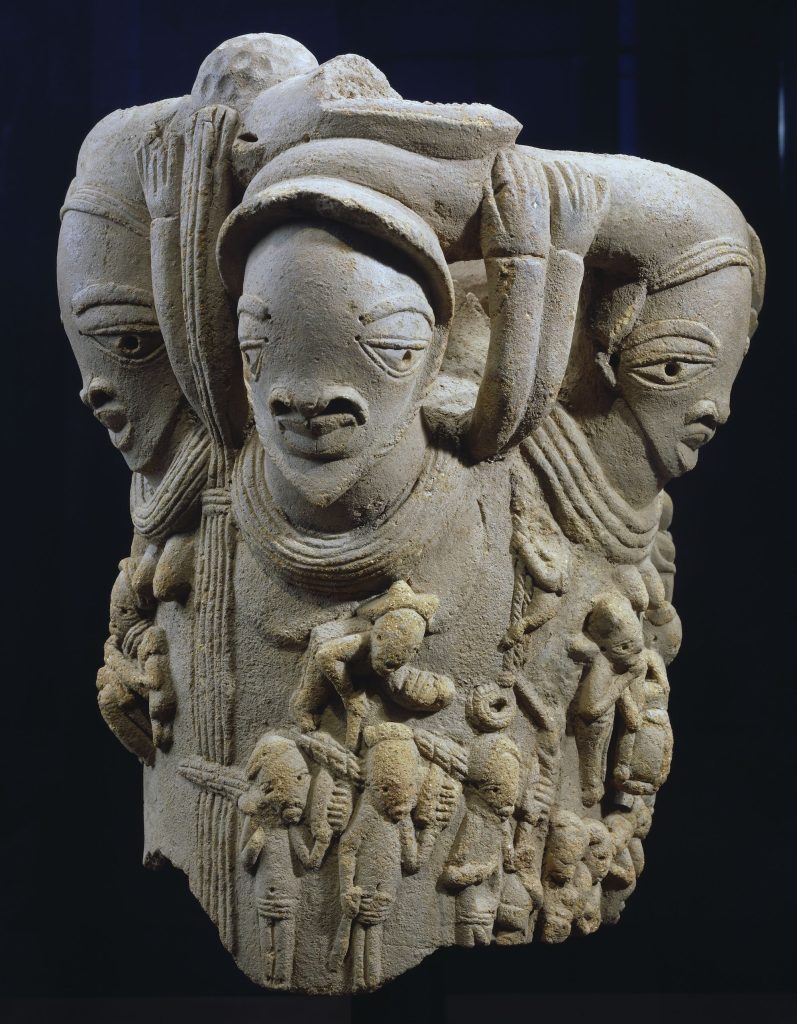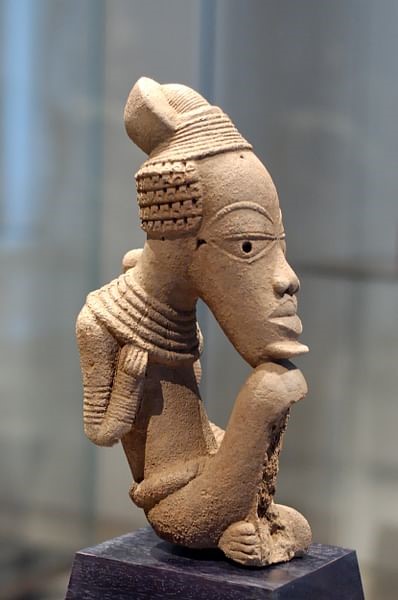នៅអំឡុងដើមពាក់កណ្តាលនៃទសវត្សរ៍ទី២០ ជាសម័យកាលដែលអ្នកស្រាវជ្រាវបានរកឃើញវត្ថុសិល្បៈជាច្រើនដែលធ្វើអំពីដីដុត (រូបមនុស្ស សត្វជាដើម)និង អំពីលោហធាតុផ្សេងៗ ជាពិសេសឧបករណ៍ដែក នៅក្នុងភូមិបុរាណមួយដែលហៅថា ណុក (Nok) នៅភាគកណ្តាលនៃប្រទេសនីហ្សេរីយ៉ា ដែលអ្នកស្រាវជ្រាវចាត់ទុកថាជាអរិយធម៌ដែលចាស់ជាងគេក្នុងតំបន់។ អរិយធម៌នេះមានទីតាំងស្ថិតនៅក្បែរនឹងខ្ពង់រាប ចូស (Jos) និងស្ថិតនៅខាង កើតនៃទន្លេនីហ្សើ (Niger)។
នៅឆ្នាំ ១៩៤៣ អ្នកបុរាណវិទូ ជនជាតិអង់គ្លេសម្នាក់ឈ្មោះ លោក Bernard Fagg បានទៅដល់ទីតាំងភូមិណុកដែលជាភូមិបុរាណមួយ ដោយបានធ្វើការ survey និងកំណាយនៅតំបន់ទីតាំងភូមិនោះ និងប្រទះឃើញវត្ថុសិល្បៈផ្សេងៗផលិត អំពីដីដុតដែលមានទម្រង់ជាមនុស្ស ក្បាលមនុស្ស និងរូបសត្វផ្សេងៗជាដើម។ លើសពីនេះ នៅឆ្នាំ ១៩៦០លោក Fagg បានបន្តធ្វើការកំណាយនៅទីតាំងស្ថានីយមួយផ្សេងទៀត ដែលមានឈ្មោះថា Taruga ដែលស្ថិតនៅខាងត្បូង និងមានចម្ងាយប្រមាណជាង៥៥គីឡូម៉ែត្រពីរាជធានី អាបូចា (Abuja)នៃប្រទេសនីហ្សេរីយ៉ា(រូបលេខ២)។ បន្ទាប់ពីកំណាយនៅទីតាំងស្ថានីយនេះរួច អ្នកស្រាវជ្រាវបានដឹងថាទីតាំងស្ថានីយ៍នេះ ជាទីតាំងដ៏សំខាន់នៅក្នុងអរិយធម៌ណុក ដោយបានរកឃើញនូវភស្តុតាងសំខាន់ជាច្រើនដូចជា វត្ថុសិល្បៈអំពីដីដុត (Terracotta) និងបានរកឃើញនូវចង្រ្កាន្តសម្រាប់ចម្រាញ់ថ្មរ៉ែដែក ឬចង្រ្កាន្តស្លដែកសម្រាប់ផលិតឧបករណ៍ដែក។ ឧបរណ៍ដែកទាំងនោះមានដូចជាពូថៅ ចប់ជីក ចប់កាប់ជាដើម ដែលសម្រាប់ប្រើប្រាស់កសិកម្ម និងជីវភាពប្រចាំថ្ងៃ។ តាមរយៈការសិក្សាលើកាបូន១៤លើវត្ថុសិល្បៈទាំងនោះ អ្នកស្រាវជ្រាវបានលើកឡើងថាអរិយធម៌នេះ កកើតឡើងនៅរវាងស.វ.ទី៥ មុនគ.ស.រហូតដល់ស.វ.ទី២មុនគ.ស និងបើតាមការសិក្សាលើចង្រ្កាន្តស្លដែកទាំងនោះ អរិយធម៌នេះអាចមានអាយុកាលចាស់ជាងនេះទៅទៀត ពោលអាចនៅ១០០០ឆ្នាំមុនគ.ស. បើប្រៀបធៀបទៅនឹងវិធីសាស្រ្តចម្រាញ់រ៉ែដែកនៅតំបន់ Hittites ដែលមានអាយុកាលជាង១៥០០ឆ្នាំមុនគ.ស.។ ទោះបីជាយ៉ាងណា វត្ថុសិល្បៈនៃអរិយធម៌នេះបានបង្ហាញថា ណុកជាអរិយធម៌ដែលចាស់ជាងគេនៅក្នុងតំបន់ sub-Saharan និងបង្ហាញវិសាលភាពទឹកដីនៃអរិយធម៌នេះដោយគ្រប់គ្រង់នៅតំបន់កណ្តាល និងខាងជើងនៃប្រទេសនីហ្សេរីយ៉ា។

មនុស្សក្នុងអរិយធម៌នេះមានជំនាញក្នុងការផលិតវត្ថុសិល្បៈ តាមទម្រង់ប្លែក តែមានបច្ចេកទេសខ្ពស់ ដែលភាគច្រើនប្រើប្រាស់បច្ចេកទេសស្លូនដី ទៅជារូបអ្វីមួយ រួចដុតឱ្យឆ្អិន និងមានបច្ចេកទេសក្នុងការស្លដែក ដែលប្រើប្រាស់ចង្ក្រាន្តហៅជាអង់គ្លេសថា Bloomery ដែលជាចង្រ្កាន្តនេះច្រើនប្រើប្រាស់នៅក្នុងតំបន់ទ្វីបអាហ្រ្វិច ( រូបលេខ៣-៥ )។
អ្នកស្រាវជ្រាវពុំដឹងអំពីមូលហេតុច្បាស់លាស់ នៃការដួលរលំអរិយធម៌ណុកនេះទេ ប៉ុន្តែប្រហែលមកពីការប្រែប្រួលអាកាសធាតុក្នុងតំបន់ និងមានការឈ្លានពីអរិយធម៌ដទៃទៀត និងមានកត្តាផ្សេងៗដែលធ្វើឱ្យអរិយធម៌ដែលមានបច្ចេកទេសនេះដួលរលំ។
សរុបមកអរិយធម៌នេះជាអរិយធម៌ដែលមានបច្ចេកទេសក្នុងការចម្រាញ់រ៉ែ ដែក និងបច្ចេកទេសផលិតវត្ថុសិល្បៈអំពីដីដុត។ តាមរយៈវត្ថុទាំងនោះ បានបង្ហាញថាអរិយធម៌នេះមានឥទ្ឋិពលរបស់ខ្លួនរយៈពេលប្រមាណ៣០០ឆ្នាំ ពោលចាប់ឆ្នាំ ៥០០មុនគ.ស.រហូតដល់ឆ្នាំ២០០មុនគ.ស.៕
——————————————————-
Nok Civilization
In the half of the 20th century CE, researchers discovered artifacts made of earthenware (the sculptures human, animals, etc.) and other metals, especially iron tools, in an ancient village called Nok at the central of Nigeria, which researchers consider to be the oldest civilization in the region. This civilization is located near the Jos Plateau and east of the Niger River.
In 1943, a British archaeologist named Bernard Fagg arrived at the site of the ancient village of Nok, conducting a survey and excavation of the site, and found sculptures made of Terracotta of humans, human heads, animals, etc. In addition, in 1960, Fagg continued to excavate at another station called Taru ga, located more than 55 kilometers south of Abuja capital city of Nigeria. After excavating this site, researchers had known that it was an important site in the Nok civilization, and found important evidences such as terracotta sculptures and a stove for refining iron ore or iron-smelting furnace for the production of iron tools. These tools include ax, digging spade, hoe, etc., which are used for agriculture and daily life. According to the carbon 14 determined on these artifacts, researchers suggest that this civilization exited between the 5th century BCE and the 2nd century CE. According to the study of the iron-smelting furnaces, this civilization maybe even older, that is, in 1000 BC compared to refining iron ore methods in the Hittites, which date back more than 1,500 BC. However, the artifacts of this civilization show that Nok is the oldest civilization in the sub-Saharan region and show the territorial scope of this civilization, ruling in central and northern Nigeria.
People in this civilization are skilled in the production of artifacts in a unique but highly technical form, most of which uses the technique of molding the earth into sculptures and then burns it until good quality, and has a technique for smelting iron using a stove called the English Bloomery, and this stove is widely used in Africa.
Researchers do not know the exact cause of the collapse of the Nok civilization, but perhaps due to climate change in the region, the invasion of other civilizations, and various factors that caused the collapse of this technological civilization.
In short, this civilization is a civilization that has the technique of refining iron ore and the technique of producing art objects from burnt earth. These objects show that this civilization had its influence for about 300 years, from 500 BCE to 200 BC.
អត្ថបទដើម៖ លោក អេង តុលា








